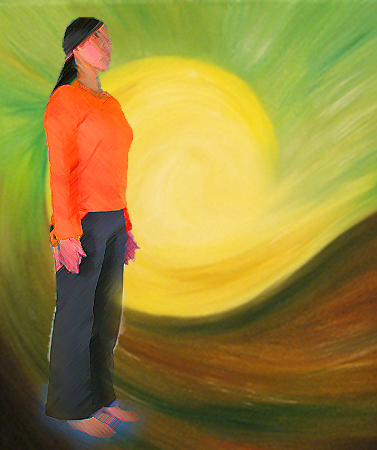
Image from this page
When people think of meditation, many immediately conjure an image of someone sitting cross-legged on the floor. But traditional Buddhist teachings list four meditation postures: sitting, walking, standing and lying down. As Buddhist teacher Gil Fronsdall has noted; “All four are valid means of cultivating a calm and clear mindfulness of the present moment.”
Today’s topic is on standing meditation, one of the lesser discussed meditation postures. When on a formal retreat, where hour-long sittings are often the norm, you may notice fellow retreatants arising into a standing posture to do this kind of meditation, to change up their posture or because they feel they need a break from long sittings. We invite members of The Meditation Circle to do likewise during our meditation sessions if they feel so inclined.
In standing meditation, the basic practice is to stand comfortably, feeling the sensations in your feet and the points of contact with the ground beneath you. One can also continue to pay attention to the breath, but the perception of the body standing becomes the primary object of meditation.
Any worry or anxiety impedes the practice. This worry can arise if one feels that the only proper way to meditate is in the sitting posture or they “should” be sitting in meditation.
The first step is to relax the whole body. One can use mental images if necessary, directed towards relaxing specific areas of the body. Try to create kinaesthetic images (sensations in the body) rather than visual images.
Stand with your feet about the width of your shoulders apart, with feet parallel or toes pointing slightly out, whichever is more comfortable. Bend your knees slightly so that you can relax the lower back. Feel the whole body soft and balanced. Feel that your head is held as if suspended from above by a string attached to the crown of the head. The neck will then be relaxed and free from any tension. The spine, and especially the coccyx, should hang down — an image of reaching down with your bottom, as if about to sit on a high stool, can help with this. Eyes can be either open or closed, mouth nearly open (but not quite), breathing softly and quietly, preferably through the nose.
After a period of settling down, start observing how your body keeps the balance. Gradually you will become aware of small movements of your body. At the beginning, you are likely to feel the whole body sway a little and get automatically corrected into a balanced position. Try not to control these movements but imagine standing in warm water and feel your body swaying as if moved by slow waves. Feel the whole body swaying as one unit — do not move your arms independently of the body. Some people, because they think their body should be still in standing postures, try to keep the body motionless. That is a mistake — the body should be as soft and relaxed as possible.
The emphasis should be on relaxing all your muscles and feeling how the body balances against gravity. Slow, very subtle movements can be felt and these are used and controlled, first in a passive manner, later actively, using kinaesthetic visualisation.
The role of standing meditation is to relax the body and develop a whole-body connection. This means that a movement in any part of the body can be felt to propagate through the whole body in a natural fashion. The process is characterized by gradually becoming aware of the internal structure of the body and then gaining some measure of control over it.
~ Thad
+ + +
The information above draws from various sources:
1) mindfulnessandpsychotherapy.com/podcast/standing-meditation-guided-meditation/
2) taichibasics.com/zhan-zhuang-pole-standing-different-qi-gong-meditation/
See also:
www.yiquan.org.uk/art-zz.html


